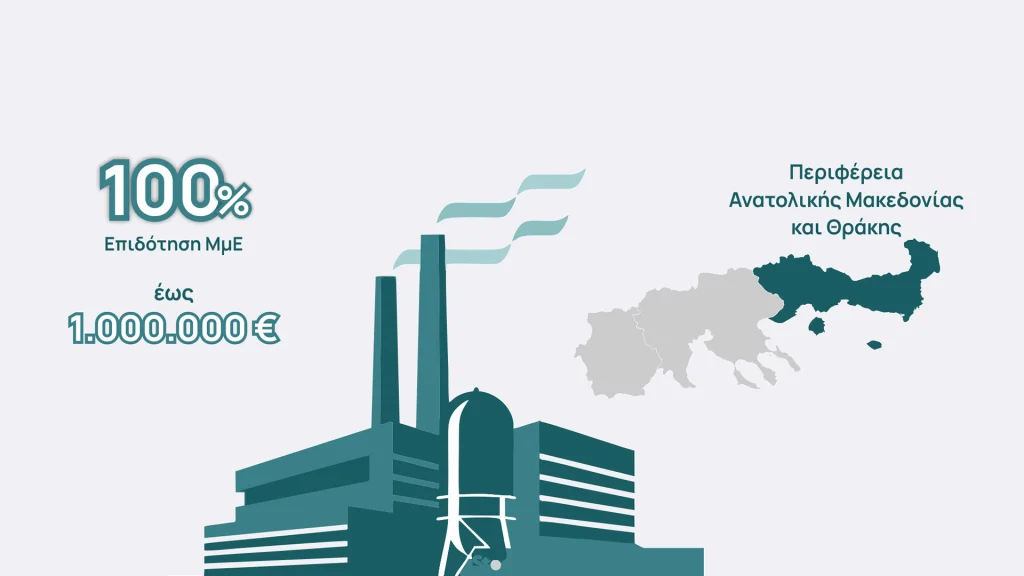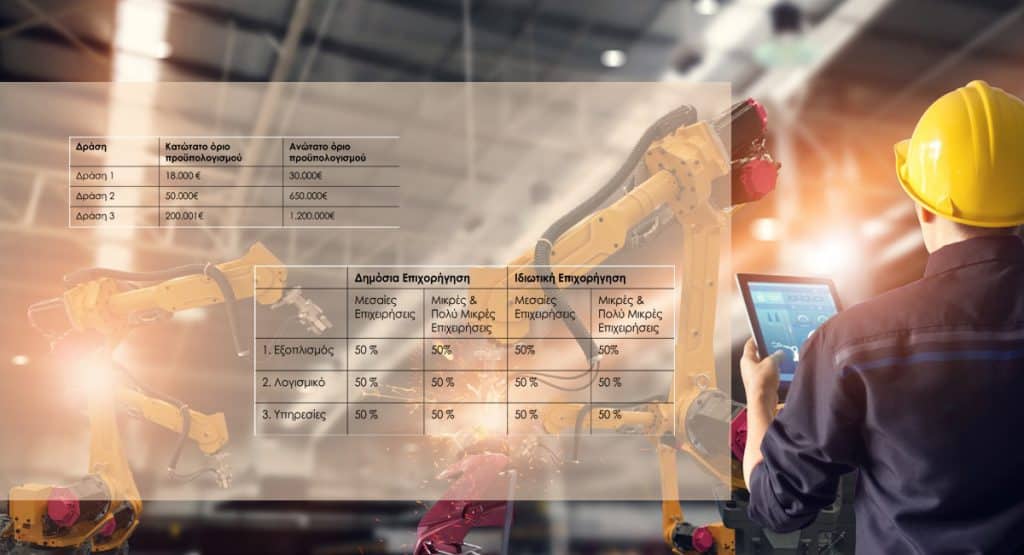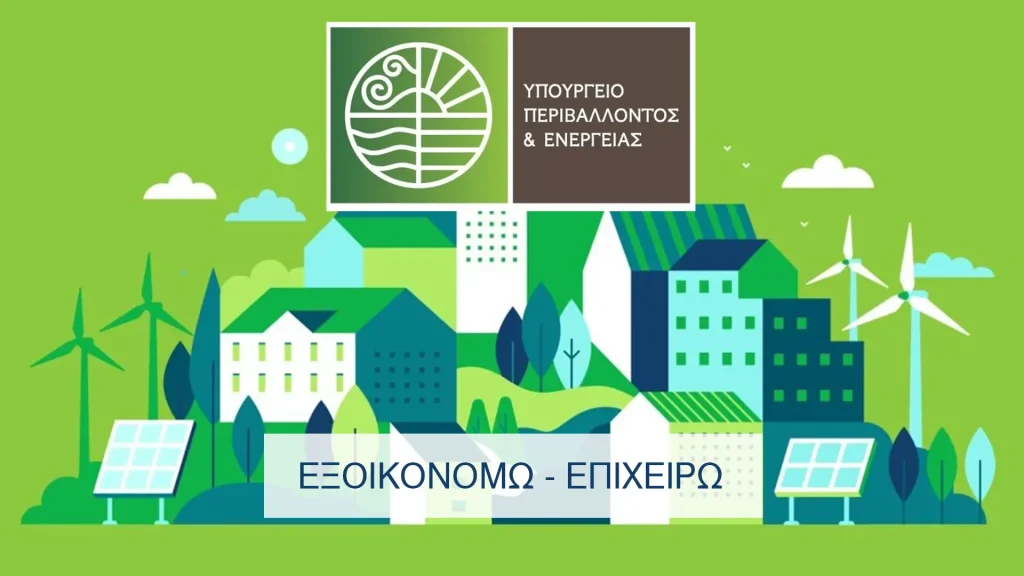
Purpose of the action:
The aim of this new action is to help businesses adopt new technologies to increase the productivity and competitiveness of Greek enterprises.
Who the program is for:
Existing very small, small, and medium-sized enterprises.
Depending on the existing digital and technological maturity of each business, it can be included in one of the following actions:
- Action 1 – Basic Digital Transformation of SMEs: Targets businesses that have not yet integrated significant Information and Communication Technology (ICT) into their operations and aims to address basic deficiencies in applications and equipment.
- Action 2 – Advanced Digital Transformation of SMEs: Targets businesses aiming to expand their digital and technological maturity with comprehensive investments in new ICTs that will enhance their competitiveness.
- Action 3 – Cutting-edge Digital Transformation of SMEs: Targets businesses that have already integrated ICT into many of their operations and now seek to implement comprehensive investments in cutting-edge technologies or solutions related to the 4th Industrial Revolution.
Eligibility criteria:
Indicative eligibility criteria are as follows:
- Submit one and only one funding application per Tax Identification Number (TIN).
- Operate within the Greek territory and make investments exclusively in one Regional Category (with the same level of aid intensity).
- Keep Single-entry or Double-entry accounting records and have at least one (1) full closed financial year.
- Operate in the eligible NACE code of the investment plan for at least one (1) year.
- The investment plan must exclusively concern eligible activities.
- Have at least five (5) Full-Time Equivalent (FTE) employees, either full-time or part-time, during the calendar year preceding the funding application submission.
- Operate legally, possessing the appropriate operational license according to applicable laws.
- Operate exclusively as corporate/commercial enterprises.
- Not be in bankruptcy, liquidation, or compulsory administration.
- The physical investment must not be completed or fully implemented before submitting the funding application.
- Comply with the requirements of EU Regulation 1407/2013 (De Minimis). The total amount of de minimis aid received by the single enterprise, including the aid from this Action, must not exceed €200,000 (or €100,000 for the road freight transport sector for third parties) within three years (current financial year and the two (2) previous financial years) before the legal entitlement to aid.
What does the program subsidize?
The subsidy varies according to the action in which the respective business belongs. Specifically:
Basic expenditure covered:
- Equipment Expenses: Indicative expenses include procuring digital office equipment, upgrading internal data transfer networks, and systems for interaction with employees, customers, or suppliers, etc.
- Software Expenses: Indicative expenses include procuring essential applications for business resources & processes management (e.g., ERP, WMS, KPIs, EDI, BPMs), image processing, 3D modeling and CAD, digital security, customer management, supply chain management, production optimization, etc.
- Service Expenses: Related to digital upgrades, indicative expenses include consulting support for the implementation of the investment plan, technical support for the execution of the investment plan, installation, or customization of applications included in the funding application.
Main expenditure categories:
- Equipment: Indicative expenses include procuring advanced operational systems for facilities or personnel, production automation with robotic systems, CNC machines, 3D printers, 3D scanners, upgrading internal data transfer networks, procuring advanced technological systems and mechanical equipment for producing Industry 4.0 systems and equipment, security systems (e.g., space surveillance, cyber protection, etc.), automation systems, robotic systems, digital sensors and controllers, digitally controlled mechanical equipment, advanced digital production systems, etc.
- Applications/Software: Indicative expenses include procuring modern applications for managing business resources & processes (e.g., ERP, WMS, EDI, BPMs, etc), image processing, 3D modeling and CAD, IoT, Big Data analytics, digital security, customer and supply chain management, artificial intelligence tools, production optimization, upgrading services, digital facility control, etc.
- Services: Related to digital upgrades, indicative expenses include technical support for customizing and integrating new systems into SME operations, systems certification, etc.
Main expenditure categories:
- Equipment, with indicative expenses: Digitally controlled electromechanical (E/M) equipment, advanced remote operation systems for installations, automation of various stages of the value chain (production – transportation – storage) with robotic systems, upgrading of internal data transfer networks, digital technology systems: interaction with employees, customers, or suppliers, Industry 4.0, digitally controlled systems, cutting-edge mechanical equipment for the production of Industry 4.0 systems, autonomous machines, robotic systems, augmented reality, cutting-edge mechanical equipment for the production of advanced security systems for spaces, etc.
- Applications/Software, with indicative expenses: Procurement of applications with enhanced intelligence for administrative and financial planning, digital security, customer and supply chain management, data analysis with artificial intelligence tools, production optimization, upgrading of provided services, blockchain, etc.
- Services related to digital upgrading, with indicative expenses: Consulting and technical support for the customization and integration of new systems into the operation of SMEs (Small and Medium-sized Enterprises), system certification, etc.
Amounts and percentages :
Budget limits:
Aid intensity in the region of Eastern Macedonia and Thrace:
So far, the Detailed Call of the Action has not been published.
With its publication, the following will also be disclosed:
Detailed participation requirements,
Required supporting documents,
The method of submitting funding applications,
The review and evaluation process,
Evaluation criteria,
Obligations of beneficiaries in case of grant approval
Other terms and conditions
For more information, request a telephone appointment by clicking the button below, and a specialized economist from our company will contact you.
The first notifications of the "Digital Transformation of SMEs" action
ΙΩΝΙΚΗ Finance
Purpose of the action:
The aim of this new action is to help businesses adopt new technologies to increase the productivity and competitiveness of Greek enterprises.
Who the program is for:
Existing very small, small, and medium-sized enterprises.
Depending on the existing digital and technological maturity of each business, it can be included in one of the following actions:
- Action 1 – Basic Digital Transformation of SMEs: Targets businesses that have not yet integrated significant Information and Communication Technology (ICT) into their operations and aims to address basic deficiencies in applications and equipment.
- Action 2 – Advanced Digital Transformation of SMEs: Targets businesses aiming to expand their digital and technological maturity with comprehensive investments in new ICTs that will enhance their competitiveness.
- Action 3 – Cutting-edge Digital Transformation of SMEs: Targets businesses that have already integrated ICT into many of their operations and now seek to implement comprehensive investments in cutting-edge technologies or solutions related to the 4th Industrial Revolution.
Eligibility criteria:
Indicative eligibility criteria are as follows:
- Submit one and only one funding application per Tax Identification Number (TIN).
- Operate within the Greek territory and make investments exclusively in one Regional Category (with the same level of aid intensity).
- Keep Single-entry or Double-entry accounting records and have at least one (1) full closed financial year.
- Operate in the eligible NACE code of the investment plan for at least one (1) year.
- The investment plan must exclusively concern eligible activities.
- Have at least five (5) Full-Time Equivalent (FTE) employees, either full-time or part-time, during the calendar year preceding the funding application submission.
- Operate legally, possessing the appropriate operational license according to applicable laws.
- Operate exclusively as corporate/commercial enterprises.
- Not be in bankruptcy, liquidation, or compulsory administration.
- The physical investment must not be completed or fully implemented before submitting the funding application.
- Comply with the requirements of EU Regulation 1407/2013 (De Minimis). The total amount of de minimis aid received by the single enterprise, including the aid from this Action, must not exceed €200,000 (or €100,000 for the road freight transport sector for third parties) within three years (current financial year and the two (2) previous financial years) before the legal entitlement to aid.

What does the program subsidize?
The subsidy varies according to the action in which the respective business belongs. Specifically:
Basic expenditure covered:
- Equipment Expenses: Indicative expenses include procuring digital office equipment, upgrading internal data transfer networks, and systems for interaction with employees, customers, or suppliers, etc.
- Software Expenses: Indicative expenses include procuring essential applications for business resources & processes management (e.g., ERP, WMS, KPIs, EDI, BPMs), image processing, 3D modeling and CAD, digital security, customer management, supply chain management, production optimization, etc.
- Service Expenses: Related to digital upgrades, indicative expenses include consulting support for the implementation of the investment plan, technical support for the execution of the investment plan, installation, or customization of applications included in the funding application.
Main expenditure categories:
- Equipment: Indicative expenses include procuring advanced operational systems for facilities or personnel, production automation with robotic systems, CNC machines, 3D printers, 3D scanners, upgrading internal data transfer networks, procuring advanced technological systems and mechanical equipment for producing Industry 4.0 systems and equipment, security systems (e.g., space surveillance, cyber protection, etc.), automation systems, robotic systems, digital sensors and controllers, digitally controlled mechanical equipment, advanced digital production systems, etc.
- Applications/Software: Indicative expenses include procuring modern applications for managing business resources & processes (e.g., ERP, WMS, EDI, BPMs, etc), image processing, 3D modeling and CAD, IoT, Big Data analytics, digital security, customer and supply chain management, artificial intelligence tools, production optimization, upgrading services, digital facility control, etc.
- Services: Related to digital upgrades, indicative expenses include technical support for customizing and integrating new systems into SME operations, systems certification, etc.
Main expenditure categories:
- Equipment, with indicative expenses: Digitally controlled electromechanical (E/M) equipment, advanced remote operation systems for installations, automation of various stages of the value chain (production – transportation – storage) with robotic systems, upgrading of internal data transfer networks, digital technology systems: interaction with employees, customers, or suppliers, Industry 4.0, digitally controlled systems, cutting-edge mechanical equipment for the production of Industry 4.0 systems, autonomous machines, robotic systems, augmented reality, cutting-edge mechanical equipment for the production of advanced security systems for spaces, etc.
- Applications/Software, with indicative expenses: Procurement of applications with enhanced intelligence for administrative and financial planning, digital security, customer and supply chain management, data analysis with artificial intelligence tools, production optimization, upgrading of provided services, blockchain, etc.
- Services related to digital upgrading, with indicative expenses: Consulting and technical support for the customization and integration of new systems into the operation of SMEs (Small and Medium-sized Enterprises), system certification, etc.
Amounts and percentages :
Budget limits:
Aid intensity in the region of Eastern Macedonia and Thrace:
So far, the Detailed Call of the Action has not been published.
With its publication, the following will also be disclosed:
Detailed participation requirements,
Required supporting documents,
The method of submitting funding applications,
The review and evaluation process,
Evaluation criteria,
Obligations of beneficiaries in case of grant approval
Other terms and conditions
For more information, request a telephone appointment by clicking the button below, and a specialized economist from our company will contact you.











